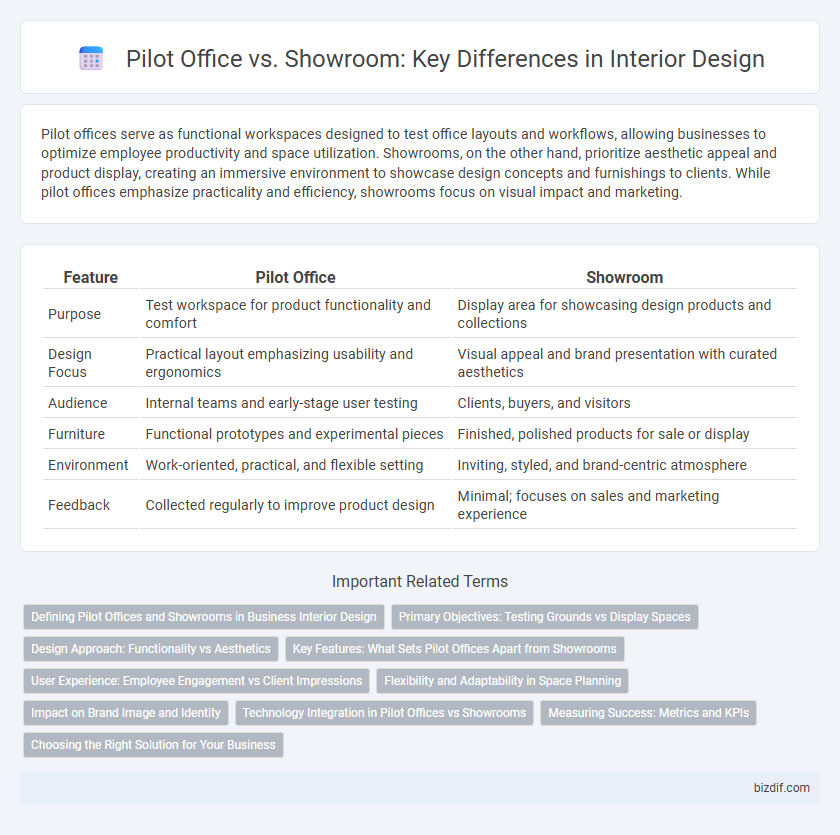Pilot offices serve as functional workspaces designed to test office layouts and workflows, allowing businesses to optimize employee productivity and space utilization. Showrooms, on the other hand, prioritize aesthetic appeal and product display, creating an immersive environment to showcase design concepts and furnishings to clients. While pilot offices emphasize practicality and efficiency, showrooms focus on visual impact and marketing.
Table of Comparison
| Feature | Pilot Office | Showroom |
|---|---|---|
| Purpose | Test workspace for product functionality and comfort | Display area for showcasing design products and collections |
| Design Focus | Practical layout emphasizing usability and ergonomics | Visual appeal and brand presentation with curated aesthetics |
| Audience | Internal teams and early-stage user testing | Clients, buyers, and visitors |
| Furniture | Functional prototypes and experimental pieces | Finished, polished products for sale or display |
| Environment | Work-oriented, practical, and flexible setting | Inviting, styled, and brand-centric atmosphere |
| Feedback | Collected regularly to improve product design | Minimal; focuses on sales and marketing experience |
Defining Pilot Offices and Showrooms in Business Interior Design
Pilot offices serve as experimental workspaces where businesses test furniture layouts, ergonomic solutions, and technology integrations before full-scale implementation. Showrooms function as curated spaces designed to display a wide range of interior design products, materials, and furniture, allowing clients to experience and select options for their projects. Both pilot offices and showrooms play critical roles in business interior design by bridging the gap between concept validation and client engagement.
Primary Objectives: Testing Grounds vs Display Spaces
Pilot offices serve as controlled environments to test spatial layouts, furniture ergonomics, and workflow efficiency before large-scale implementation. Showrooms prioritize aesthetic presentation, showcasing finished design concepts, materials, and furnishings to attract clients and drive sales. The primary objective of pilot offices is functional validation, while showrooms focus on visual appeal and customer experience.
Design Approach: Functionality vs Aesthetics
Pilot offices prioritize functionality, emphasizing efficient layouts, ergonomic furniture, and adaptable spaces to support daily operations and employee productivity. Showrooms focus on aesthetics, highlighting visually appealing designs, innovative materials, and striking displays to captivate clients and showcase products. Balancing functionality with aesthetic appeal is crucial in interior design to meet both operational needs and brand representation.
Key Features: What Sets Pilot Offices Apart from Showrooms
Pilot offices prioritize functionality and real-time user feedback, serving as experimental environments for testing design elements and workflows before full-scale implementation. Unlike showrooms, which emphasize aesthetic appeal and staged settings to showcase products, pilot offices enable iterative adjustments based on employee interaction and operational efficiency. Key features include flexible layouts, integrated technology for productivity tracking, and adaptable furnishings that reflect actual workplace dynamics.
User Experience: Employee Engagement vs Client Impressions
Pilot offices prioritize employee engagement by creating functional layouts that enhance collaboration, comfort, and productivity, directly influencing workplace satisfaction and retention. Showrooms focus on client impressions, designing visually striking spaces with curated displays that highlight products and brand identity to inspire confidence and drive sales. Optimizing user experience in both environments requires balancing aesthetic appeal with functionality tailored to their distinct audience needs.
Flexibility and Adaptability in Space Planning
Pilot offices offer enhanced flexibility by allowing designers to experiment with layout configurations and furniture arrangements in real-time, adapting quickly to evolving team needs and workflow changes. Showrooms, while designed to showcase finalized designs, provide limited adaptability as their primary function is to present static, curated environments for client visualization. Effective space planning prioritizes the dynamic nature of pilot offices to foster innovation, whereas showrooms emphasize aesthetic consistency and controlled ambiance.
Impact on Brand Image and Identity
Pilot offices serve as real-world environments that reflect a brand's culture, fostering authentic experiences that strengthen identity and enhance employee alignment. Showrooms function as curated spaces showcasing a brand's products and aesthetic, reinforcing visual identity and attracting targeted clientele through immersive displays. Choosing between a pilot office and showroom significantly influences how a brand's personality and values are perceived by internal teams and external audiences.
Technology Integration in Pilot Offices vs Showrooms
Pilot offices utilize advanced technology integration such as IoT devices, smart lighting, and real-time analytics to optimize workspace efficiency and employee productivity. Showrooms emphasize immersive technology like virtual reality, augmented reality, and interactive displays to enhance customer engagement and showcase products dynamically. The strategic deployment of technology in pilot offices focuses on functional innovation, whereas showrooms prioritize experiential innovation.
Measuring Success: Metrics and KPIs
Measuring success in pilot offices centers on KPIs such as employee productivity, space utilization rates, and user satisfaction scores, which help evaluate the functionality and adaptability of design concepts. Showrooms primarily track metrics like visitor engagement, conversion rates, and average dwell time to assess the effectiveness of visual merchandising and client experience. Both environments rely on qualitative feedback and quantitative data to refine interior design strategies and achieve targeted business outcomes.
Choosing the Right Solution for Your Business
Selecting between a pilot office and a showroom depends on your business goals and operational needs; a pilot office offers a functional workspace ideal for team collaboration and testing layout concepts, while a showroom emphasizes product display and customer experience with polished design elements. Analyze your target audience and interaction type--pilot offices facilitate internal workflow optimization, whereas showrooms enhance brand presentation and client engagement. Investing in the right solution can elevate productivity or sales impact by aligning interior design with specific business functions.
Pilot Office vs Showroom Infographic

 bizdif.com
bizdif.com